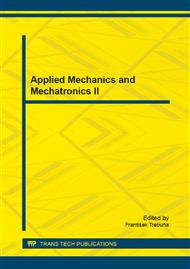p.383
p.389
p.397
p.404
p.412
p.416
p.421
p.426
p.437
Comparison of Different Estimation Algorithms Used in the Experimental Determination of Modal Parameters
Abstract:
The paper deals with the estimation of modal parameters and its main purpose is to compare differences in the values of natural frequencies and damping ratios, which were estimated using three different extraction methods: Rational Fraction Polynomial method, Complex Mode Indicator Function and Polyreference Time Domain Technique. These methods are well suited to the more general application to multi-FRF data, both of the SIMO and the MIMO types. The object of measurement was a freely suspended steel rod of circular cross section. The responses of the analyzed structure were measured by accelerometer and laser vibrometer. The results of these measurements are also discussed in the paper.
Info:
Periodical:
Pages:
412-415
Citation:
Online since:
November 2015
Authors:
Price:
Сopyright:
© 2015 Trans Tech Publications Ltd. All Rights Reserved
Share:
Citation:


